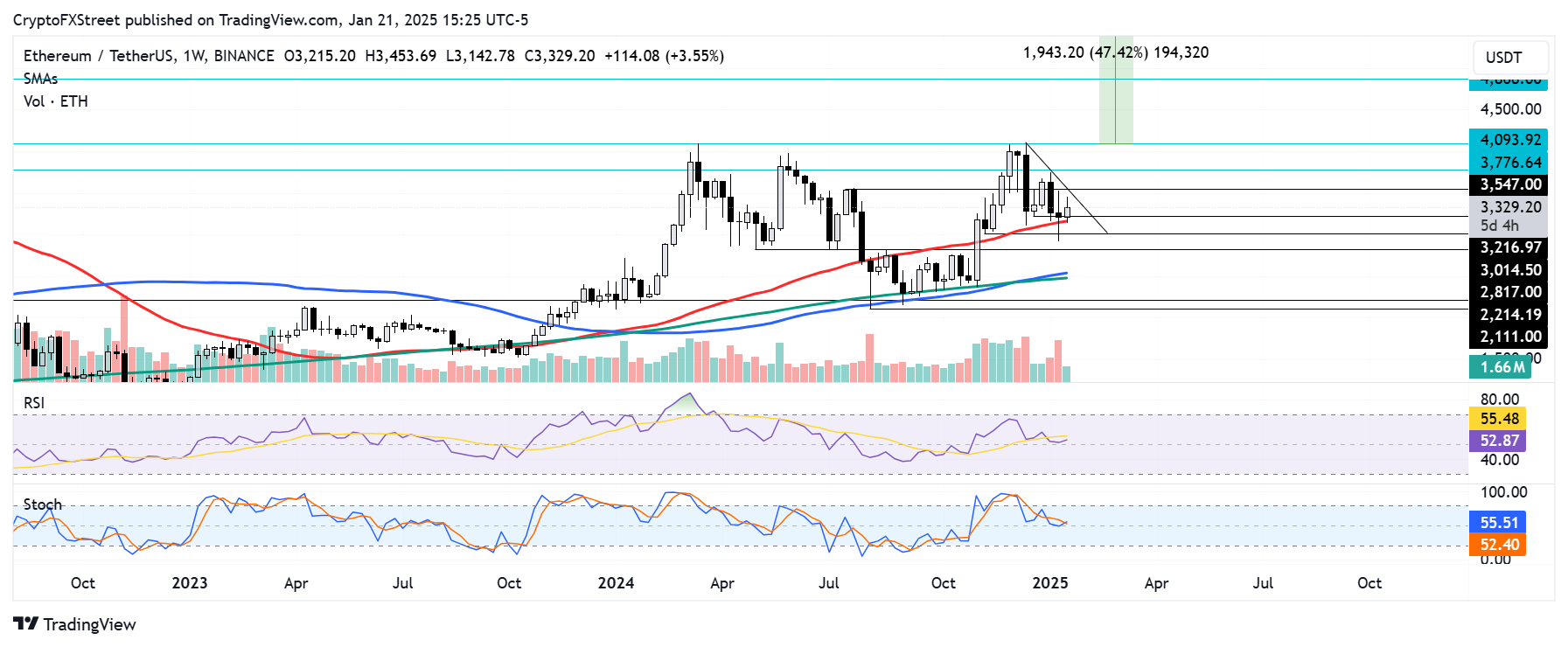Ethereum Price Forecast: ETH may not see a new all-time high in 2025 if Foundation leadership issues persist
Ethereum price today: $3,310
- Ethereum Foundation leadership criticism sparks outrage from Vitalik Buterin, who says the pressure is creating a toxic environment for top talents.
- Buterin states he's the only one responsible for establishing a new leadership at the Foundation until a proper board is established.
- The $3,216 support level has proved to be critical as ETH continues developing the right shoulder of an inverted H&S pattern.
Ethereum (ETH) trades close to the $3,300 psychological level on Tuesday after its co-founder Vitalik Buterin responded to the mounting pressure for the Ethereum Foundation executive director Aya Miyaguchi to resign. The ongoing Foundation leadership/community tussle has led to ETH significantly underperforming Bitcoin, XRP and Solana in the past week.
Ethereum's Vitalik Buterin blasts community members amid ongoing criticisms
In an X post on Tuesday, Buterin lashed out at recent calls from most Ethereum community members for Miyaguchi to leave her role as the Foundation's executive director.
He highlighted several recent harsh remarks concerning Miyaguchi were "pure evil" and an untrue scapegoat attack, referencing a misinterpreted Wired interview that suggests she hates "the culture of competing and winning."
Despite earlier moves by the Foundation's leadership to calm the community, an X user suggested that Miyaguchi would resign if the community kept the pressure on.
However, Buterin responded: "If you keep the pressure on, then you are creating an environment that is actively toxic to top talent."
"Some of Ethereum's best devs have been messaging me recently, expressing their disgust with the social media environment that people like you are creating. YOU ARE MAKING MY JOB HARDER," he added.
Buterin shared how he's the only one responsible for deciding the new Ethereum Foundation leadership team until a "proper board is established." He stated that the pressure is "decreasing the chance I have any interest whatsoever in doing 'what you want.'"
Former Ethereum researcher Danny Ryan, who many influential community members have suggested to take over the reins from Miyaguchi, also commented that the recent discussions concerning the Foundation's leadership on X have turned "counterproductive."
"With or without me, the EF is evolving and for the better. You've been heard, but vitriol is ultimately harmful to this process," wrote Ryan.
Buterin had earlier announced that the Ethereum Foundation is undergoing "large changes" to its leadership structure, including improving execution ability and speed, supporting app builders actively and improving the level of technical expertise.
The ongoing Foundation issues have deterred new investment as ETH has been underperforming Bitcoin, XRP and Solana in the past week. Despite the bullish market sentiments, ETH may post a poor run in 2025 if the Foundation's issues persist.
Meanwhile, Ethereum ETFs recorded inflows of $23.90 million on Monday, marking a fourth consecutive day of positive flows.
Ethereum Price Forecast: ETH holds $3,216 support as it eyes move toward $4,100
Ethereum saw over $36.04 million in futures liquidations in the past 24 hours, per Coinglass data. The total amount of liquidated long and short positions is $23.57 million and $12.48 million, respectively.
On the weekly chart, Ethereum continues to develop the right shoulder of an inverted Head-and-Shoulders (H&S) pattern as it maintains the support level near $3,216. This level is strengthened by the 50-day Simple Moving Average (SMA), which has been a critical support since ETH's plunge in December.

ETH/USDT weekly chart
On the upside, ETH has to overcome a key descending trendline resistance — extending from December 16 — and the $3,550 level to help strengthen its quest to tackle the critical resistance near $4,100. A sustained rally above $4,100 while establishing it as a support level validates the inverted H&S pattern. Such a move could see ETH surge above $4,868 to set a new all-time high.
The Relative Strength Index (RSI) and Stochastic Oscillator (Stoch) are above their neutral levels, indicating dominant bullish momentum.
A weekly candlestick close below the support level at $2,817 will invalidate the thesis.
Ethereum FAQs
Ethereum is a decentralized open-source blockchain with smart contracts functionality. Its native currency Ether (ETH), is the second-largest cryptocurrency and number one altcoin by market capitalization. The Ethereum network is tailored for building crypto solutions like decentralized finance (DeFi), GameFi, non-fungible tokens (NFTs), decentralized autonomous organizations (DAOs), etc.
Ethereum is a public decentralized blockchain technology, where developers can build and deploy applications that function without the need for a central authority. To make this easier, the network leverages the Solidity programming language and Ethereum virtual machine which helps developers create and launch applications with smart contract functionality.
Smart contracts are publicly verifiable codes that automates agreements between two or more parties. Basically, these codes self-execute encoded actions when predetermined conditions are met.
Staking is a process of earning yield on your idle crypto assets by locking them in a crypto protocol for a specified duration as a means of contributing to its security. Ethereum transitioned from a Proof-of-Work (PoW) to a Proof-of-Stake (PoS) consensus mechanism on September 15, 2022, in an event christened “The Merge.” The Merge was a key part of Ethereum's roadmap to achieve high-level scalability, decentralization and security while remaining sustainable. Unlike PoW, which requires the use of expensive hardware, PoS reduces the barrier of entry for validators by leveraging the use of crypto tokens as the core foundation of its consensus process.
Gas is the unit for measuring transaction fees that users pay for conducting transactions on Ethereum. During periods of network congestion, gas can be extremely high, causing validators to prioritize transactions based on their fees.

